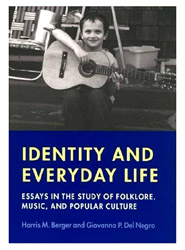| |
 In this book, Berger and Del Negro have tried to offer an extended revision of two complicated concepts and its implications in both theory and practice. Both identity and everyday life are commonly used terms in academic writing, but, as they point out, most of the times the terms are just used instead of being defined and discussed. One of the strengths of this book is the effort to move from theory to practical examples trying to be clear, pedagogic and sophisticated at the same time.
At the same time that the authors make a revision of basic literature on this concepts, they provide a lot of examples taken from ethnography: from Italian passegiata (ritual promenade) to the experience of heavy metal or jazz musicians on stage we, as readers, are able to live an experience and we are provided with theoretical skills in order to give meaning to that. They are also able to offer their own experiences as examples, considering that nobody will be more accurate in order to explain the details and meanings of they that the person who have lived trough this.
The emphasis on lived experiences as basic data for research reveals a programmatic approach to ethnographic research methods: Berger and Del Negro point out in several pages that they defend a populist vision of culture, maintained that most aspects of everyday life have a creative and aesthetic component. So, they tried to identificate those elements in observation and participation, leaving semiotics and using phenomenology.
The aesthetic side of everyday practice is the basic idea that unifies their reflections trough the book: the authors use the sophisticated philosophical ideas of Husserl and Schutz in order to defend that both performance and reception are social activities that require control and elaboration, also when musicians try to reach this optimal state of involvement on music usually described as the loss of self. In this way, the book is very rich in details about how a musician is able to sing or play guitar in order to communicate to the audience how deeply involved is he in music and what he expects from him listeners. Although Berger and Del Negro carefully mark the central importance of context in the process to give meaning to this kind of expressive acts, they always emphasize the necessity of agency, an idea that seems to be recovered on popular music studies in the last years, after being silenced previously when some cultural studies and poststructuralist approaches focussed too much on the social forces as meaning builders.
Berger and Del Negro insist in the importance of social cooperation in order to create meaning: this point is not only necessary to defend their vision of the everyday life as a creative process, but also in order to defend an humanistic idea of society as a place where we can find empirical “others” with which we can act together and build our sense of ourselves. In the way we organize our experience in music, in the ways we focus our attention in one or other musical level of the event, in the form in which we perceive ourselves as actors in a performance, the individuals trace their pathways trough popular music and are able to allocate themselves in society as creative agents, controlling their immediate social world.
Berger and Del Negro examine in details all this processes that link everyday life and identity, and are also able to make a reflection on the academic’s role on that process: it is difficult to move from lived experiences to reflexive ones, because we take the risk to misinterpret them or to privilege our own interpretation. “Because the scholarly analysis of identity is nothing more and nothing less than the interpretation of another’s interpretation, there is no general solution to these difficulties” (148). At least, this book is an interesting attempt to organize the difficulties and sketch possible solutions.
|
|

